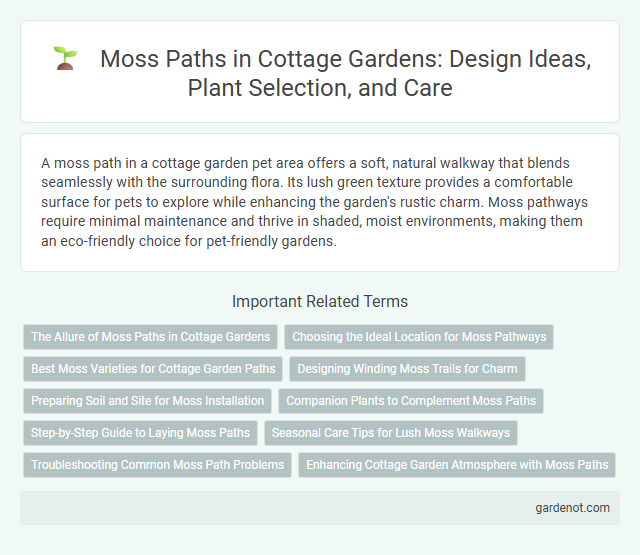A moss path in a cottage garden pet area offers a soft, natural walkway that blends seamlessly with the surrounding flora. Its lush green texture provides a comfortable surface for pets to explore while enhancing the garden's rustic charm. Moss pathways require minimal maintenance and thrive in shaded, moist environments, making them an eco-friendly choice for pet-friendly gardens.
The Allure of Moss Paths in Cottage Gardens
Moss paths in cottage gardens create a lush, velvety carpet that enhances the natural, whimsical charm of the outdoor space. Their soft texture and rich green hues provide an eco-friendly, low-maintenance alternative to traditional stone or gravel walkways, promoting moisture retention and soil health. These enchanting pathways invite barefoot strolls and effortlessly blend with surrounding perennials and wildflowers, embodying the timeless appeal of rustic garden design.
Choosing the Ideal Location for Moss Pathways
Selecting the ideal location for moss pathways involves identifying shaded, moist areas with well-drained soil to ensure optimal moss growth and longevity. Avoiding direct sunlight and heavy foot traffic preserves the delicate moss texture and vibrant green color essential for a charming cottage garden aesthetic. Incorporating native moss species adapted to local climate conditions further enhances the path's resilience and visual appeal.
Best Moss Varieties for Cottage Garden Paths
Best moss varieties for cottage garden paths include Cushion Moss (Leucobryum glaucum), known for its soft, dense mats and vibrant green color that thrives in shaded, moist areas. Irish Moss (Sagina subulata) creates a low-growing, bright green carpet with tiny white flowers, ideal for small gaps between stepping stones. Sheet Moss (Hypnum imponens) offers excellent ground cover with its flat, spreading growth habit, perfect for adding texture and charm to rustic pathways.
Designing Winding Moss Trails for Charm
Design winding moss trails to enhance the enchanting charm of a cottage garden by selecting shade-tolerant moss varieties like sheet moss or cushion moss, which thrive in moist, shaded environments. Incorporate natural curves and gentle bends to create a whimsical, organic flow that invites exploration while complementing the garden's rustic aesthetic. Ensure proper soil preparation and regular misting to maintain lush, vibrant moss trails that seamlessly integrate with surrounding plants and garden features.
Preparing Soil and Site for Moss Installation
Preparing soil and site for moss installation begins with selecting a shaded, moist area with well-draining soil to promote healthy moss growth. Remove grass, weeds, and debris, then lightly compact the soil to create a firm, smooth surface that retains moisture without becoming waterlogged. Testing soil pH to maintain a slightly acidic environment (pH 5.0 to 6.0) enhances moss establishment and longevity in the cottage garden.
Companion Plants to Complement Moss Paths
Companion plants for moss paths include shade-tolerant, moisture-loving species such as ferns, hostas, and astilbes that enhance the lush, tranquil ambiance. Woodland wildflowers like trilliums, bleeding hearts, and foamflowers provide seasonal color and texture contrasts while thriving in similar environmental conditions. Low-growing groundcovers such as creeping thyme and vinca minor also complement moss by filling gaps and adding resilience to pathways in cottage garden settings.
Step-by-Step Guide to Laying Moss Paths
Creating a moss path in a cottage garden starts with selecting a shaded, moist area where moss naturally thrives. Clear the ground of debris, level it, and press moss fragments or sheets firmly onto the soil surface, ensuring good contact to promote rooting. Regularly mist the path to maintain moisture during establishment, encouraging lush, green growth that enhances the garden's rustic charm.
Seasonal Care Tips for Lush Moss Walkways
Maintaining a moss path in a cottage garden requires consistent moisture and shaded conditions to promote lush growth. Regularly remove debris and gently rake the moss during early spring to prevent compaction and encourage healthy development. Applying a diluted liquid fertilizer in late fall helps strengthen moss cells, ensuring vibrant walkways through all seasons.
Troubleshooting Common Moss Path Problems
Moss paths often face issues like patchiness, discoloration, and excessive slipperiness due to inadequate moisture, poor soil conditions, or high foot traffic. Regularly assessing soil pH between 5.0 and 6.0 and maintaining consistent moisture without waterlogging helps promote healthy moss growth. Address compaction by aerating the path and improve drainage to prevent moss decay and ensure a lush, vibrant cottage garden walkway.
Enhancing Cottage Garden Atmosphere with Moss Paths
Moss paths add a lush, green softness that enhances the enchanting charm of a cottage garden, creating a natural, inviting walkway that complements rustic plants and flowers. Their low maintenance and shade tolerance make moss paths ideal for shaded or damp areas where grass struggles to grow, providing year-round greenery and texture. Incorporating moss paths also supports biodiversity by offering a habitat for small insects and moisture-retaining ground cover, enriching the cottage garden's ecosystem.
Moss path Infographic

 gardenot.com
gardenot.com